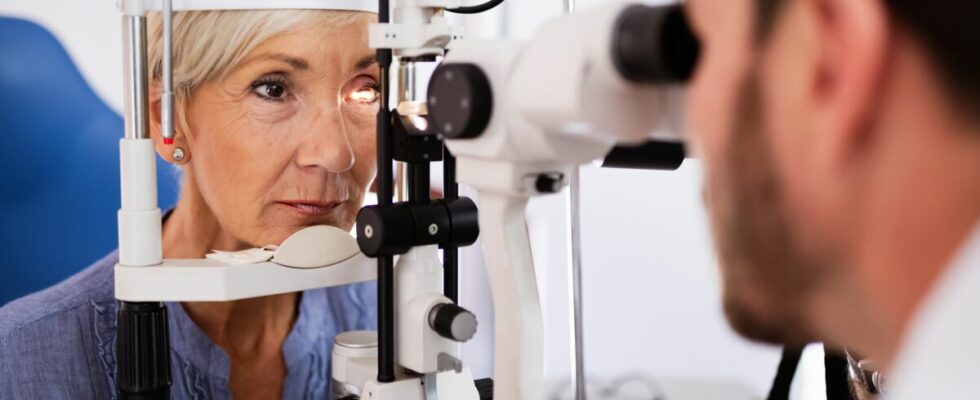Ophthalmological examination, the fundus examination is carried out systematically at each visit to the ophthalmologist and makes it possible to detect certain ocular disorders. Painless, it lasts about a minute. “THE Fundus of eye (FO) is the examination which allows you to examine the interior of the eye, the retina in particular the macula and the papilla (head of the optic nerve). It is sometimes done without pupil dilation and without contact. We insert a lens which allows us to see the inside of the eye through the pupil. We will thus analyze the macula (central area of the damaged retina in AMD), the optic nerve, the state of the retinal arteries and veins and the retina itself. This is the moment of the examination when the patient is very dazzled“, explains Dr. Véronique Krafft, ophthalmologist.
She specifies that, in some cases, it is necessary to dilate the pupil to allow better visualization of the retina, particularly at the peripheral level. Mydriasis (pupil dilation) causes dazzling, temporary loss of vision and does not allow you to drive again. “If it is necessary to dilate the pupil, the fundus examination can be done in two ways: either without contact with the same small lens as previously, or by placing another directly on the cornea after contact anesthesia. lens type or three-mirror glass. It can be overwhelming but it’s not painful. The exam then lasts 1 to 2 minutes“, specifies Dr. Krafft.
The ophthalmologist can also use fundus photographs, also called retinographies which also allow the retina and optic nerve to be analyzed, most of the time without the need for pupil dilation. During this exam, the person must sit in front of a device called a retinograph, and press their chin and forehead on the designated locations. Thanks to the emission of flashes, the camera photographs each eye two or three times. The ophthalmologist then analyzes the images. In most cases, no further examination is necessary and the photos are archived or compared to previous photos to monitor certain eye diseases. In certain cases, the ophthalmologist can use eye drops because the fundus is not visible enough or complete the examination with indirect ophthalmoscopy which is based on the use of a light source and an aspherical converging lens. .
Fundus examination: in which case?
Above all, the fundus examination allows you to check that the retina is correct! “Many ocular, neurological or metabolic diseases are asymptomatic at first and are detected using a fundus examination. This examination makes it possible to screen for AMD (age-related macular degeneration), glaucoma or search for a papilledema (of the head of the optic nerve) in the context of neurological conditions. It also allows you to search for a diabetic retinopathywhich is the leading cause of blindness in industrialized countries and which requires regular monitoring according to the balance of diabetes“, specifies Dr. Krafft.
The fundus examination also makes it possible to look for retinal detachment after pupil dilation or to identify the causes of a sudden loss of vision. Blurred vision, pain in the eye after trauma or even a sensation of “flying flies” in the eyes should prompt you to consult an ophthalmologist who can, among other things, perform a fundus examination. “The identification of abnormalities will make it possible to treat an eye disease early or to provide health and diet advice in cases of early AMD. We have all had the opportunity to detect, during a systematic fundus examination as part of a consultation for glasses, unknown diabetes, an eye tumor or even a brain tumor. We don’t see everything, but in these specific cases, we are relieved that the patient saw an ophthalmologist and did not renew their glasses at theoptician or theorthoptist where he would not have had a fundus“, explains Dr. Krafft.
Fundus examination: how often should you take this exam?
In case of known retinal pathologies such as diabetic retinopathy, it is advisable to have a fundus examination once a year. From a certain age, even in the absence of general pathologies, this examination must be carried out regularly. In the event of visual problems (presbyopia, myopia, hyperopia), a fundus check can be carried out every two years, during a general visit. In children, the fundus examination should be performed at the age of 1 year and then at 3 years. If the child’s vision does not require special monitoring, the visit for a fundus examination can then take place every 5 years. “In children, the fundus is not the reason for monitoring and the goal of the visit is rather to ensure that they are seeing and doing well. This is an element to monitor and it is useful to remember that to date only the ophthalmologist can carry out this examination.“, says Dr. Krafft.
Read also:
⋙ Examination: stress-free fundus examination
⋙ Fundus examination: why you absolutely should not skip it
⋙ AMD: what are the first signs?
